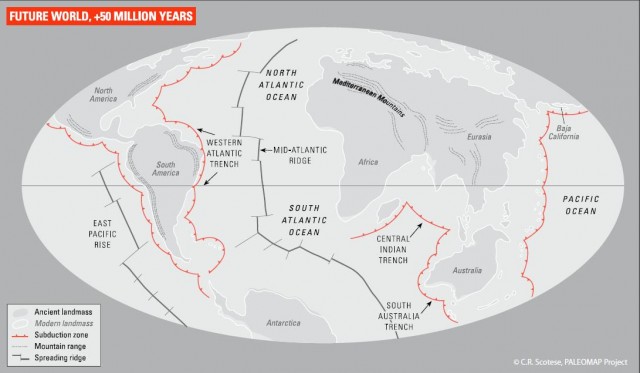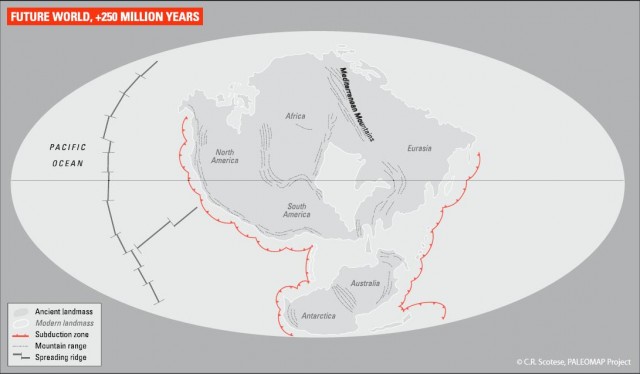In the meantime…
Our knowledge of stellar evolution, the development of stars over time, is solid enough to make the events described above pretty definite. But the many billions of years before any of this happens contain fewer certainties. What we can say for sure, however, is that nobody will be killed or even inconvenienced when the Sun boils the oceans and fries the Earth. By then, humans will either have gone extinct or spread across the galaxy, depending on your level of optimism.
Working from the inside out, the innermost layers of the Earth are perhaps the most likely to behave as we expect for many billions of years to come. Here, the process of differentiation which we met at the end of Chapter 4 will continue to operate. Over the last billion or so years, the solid inner core of the Earth has grown from nothing to some 2444km in diameter. It will carry on growing at about 0.3mm a year as the core loses heat to the crust and eventually into space. At some point, it could fill up the whole of the volume of todays core.
Likewise, the geodynamo is certain to go on doing what it does for many millions of years. As we have seen, one of its most lasting characteristics is its tendency to flip by 180° from time to time, perhaps under the influence of small perturbations caused by the growth of the inner core, irregularities in the base of the mantle, or even asteroid impact. Whatever the root cause, the switch seems to happen when the Earths magnetic field falls to about 10 percent of its peak value. As we have seen, some scientists suspect that this could be soon, partly because the magnetic field is weakening measurably and partly because it has been a long time since the last flip. However, even if the next flip is a long time in the future by our standards, many thousands more reversals lie in the Earths future. The fact that the inside of the Earth is hot means that like the core, the Earths mantle will carry on convecting indefinitely. This means that there will be drifting continents, and the volcanoes and earthquakes that go with them. But where?
One person who has attempted to answer this question is US geologist Chris Scotese who, as well as producing maps of past continental drift, has run the clock forward by millions of years. Even after 50 million years, things look noticeably different, with the Mediterranean closing up. By 250 million years in the future, the ancient continent of Pangea has more or less reassembled itself, with all the land in one large mass.
This continent will be quite unlike anything we know. Most places will be a long way from the sea. Big rivers will cross the land mass, but substantial estuaries and deltas will occur only around the edge. There will be seafloor spreading in the continuous deep ocean surrounding the land, and subduction around the edge of the continent, within which there will be a big trapped sea. All that subduction will mean lively volcanoes and earthquakes. (Scotese is careful to say that a forecast this far ahead cannot
be completely dependable.)
The future world that Scotese foresees would differ from the one we know in a number of ways. One is that it has no large land mass at either pole. This means that there would be no Antarctic ice cap because there would be no Antarctic continent. But there would also be no frozen ocean like the one we now find in the Arctic. This icy sea exists as it does because it is more or less cut ott trom the rest ot the world ocean by the American and Eurasian land masses. If there is one large land mass, ocean currents, ice distribution and even atmospheric circulation will all be different too.
In the shorter term, one of the greatest uncertainties about the Earths future is its climate. We already know that we are (as former British Prime Minister Margaret Thatcher put it) carrying out an experiment with the Earth, by releasing carbon that was stored in the crust over millions of years during a conflagration lasting just centuries.
As we saw in Chapter 8, global warming is likely to make life on Earth less comfortable for humans over the coming centuries. But what about further down the line? Although the precise details are unclear, Tim Lenton of the University of East Anglia in the UK has looked at how stable the Earth is for the life it bears, with an emphasis on water, air and land rather than the depths of the solid Earth. He points out that something not too different from todays unplanned climate experiment happened about 55 million years ago. Then, large amounts of carbon were released into the atmosphere in the form of methane. The release seems to have happened because compounds called clathrates, in which methane is trapped in ice, were melted by a comparatively small temperature rise.


The effect was probably similar to the release of methane that may take place in future in the Arctic if the permafrost melts. After this episode, it took the Earths climate about 100,000 years to regain its original condition. Models produced from this data suggest that this time, it might take about a million years for the status quo to be restored. In the meantime, you can forget about ice ages and resign yourself instead to higher sea levels. In particular, says Lenton, it takes a geological amount of time to regrow the Greenland ice cap once it has melted.
The destruction of glaciers in Greenland, the Antarctic and elsewhere is only part of the story. Other events follow from, and in turn encourage, major and hard-to-reverse climate change. These include altered ocean currents and changes to weather patterns such as the monsoon. Each of these makes the others more likely and less preventable.
Lenton himself believes in a comparatively tough version of the Gaia theory. For example, he thinks it is significant that ice ages have restarted in the last few million years, after hundreds of millions of years when they were rare. He thinks this might be a sign that Gaia is gearing up for major, but unknown, change comparable to the origin of photosynthesis.